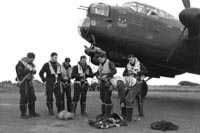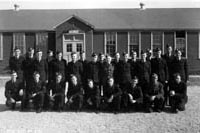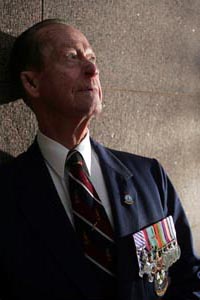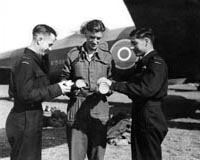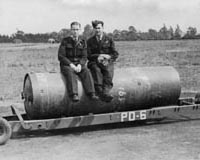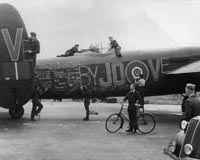|
|
|
Reg
Boys [third from left] and colleagues prepare for a mission
|
Bomber
Command
Of 32 VCs awarded to the RAF in WWII, 10 went to Lancaster crew
members
125,000
aircrew served in Bomber Command
47,000 were killed in action
9800 were taken POW
3486 Australians KIA
724 Australians killed in training
|
Bomber
Boys
Bomber
Command absorbed just 2 per cent of Australia's young men committed to
fight in World War II but accounted for 20 per cent of her total loss
of life in the conflict - 3486 killed in action. Flt-Lt Reg Boys DFC was
among those who survived to tell his tale.
WORDS
BRIAN HARTIGAN PHOTOS SUPPLIED BY REG BOYS
RAAF's No
467 Sqn, with a full-strength compliment of about 140 aircrew, recorded
almost 800 casualties in just 28 months - replacement and reinforcement
barely able to keep ahead of the statistics. Of the 590 men killed in
action in this one squadron alone, five were commanding officers.
Confident
in the strength of his European defences early in the war, Herman Goering
assured his Commander-in-Chief, Adolf Hitler, "No enemy plane will fly
over the Reich territory". In defiance of this boast and with a statistical
average life expectancy of just 13 sorties, Sydney-sider and navigator
Reg Boys flew a remarkable 40 operational sorties over enemy territory
- 11 of them over the very heart of the Reich - Berlin.
After completing
his training in Australia, Canada and England, Reg Boys was posted to
RAAF's No 467 Sqn as a navigator on Lancaster heavy bombers in June 1943.
Over the course of the next eight months, Reg flew three more than his
required 30 operational sorties before transferring as an instructor to
27 Operational Training Unit.
A little
more than a year later he was back with 467 Sqn and completed a further
seven raids over Reich territory before peace was declared.
Reg's flying
career started on home soil with basic pilot training in Victoria and
New South Wales on Tiger Moth aircraft. Recategorised as a navigator,
he was shipped off to Winnipeg, Canada where he was among the first intake
of navigators from across the Commonwealth to be trained in that country
- on Anson aircraft.
|
|
|
Reg
Boys [third from left, front row] and his graduating class, Canada,
1943
|
|
|
|
Reg
Boys DFC reflects on a distinguished flying history
|
Still on Ansons,
further training followed in England and Wales before he was eventually
invited to join a team.
"A bloke
by the name of 'Buck' Jones said he liked my training record and wanted
me to help him form a crew," Reg says.
From these
beginnings, a tight-knit crew was drawn together and began the next phase
of training on the bigger, faster Wellington bomber.
Remarkably,
it was during this phase of his long flying career that Reg had his most
serious flying mishap and, as these things go, it was rigorous training
that probably saved his life.
"One thing
we trained hard at as a crew - in our own time - was abandoning the aircraft.
We figured that if we practiced often enough, the training would kick
in and you would do the drill automatically even if you were concussed
or something.
"Well, wouldn't
you know it, one day on a training mission, a prop fell off our Wellington
at about 1000ft - and those things were lucky to fly with two good engines.
So we had to bail out quick smart."
The experience
brought the men much closer together. So much so in fact, that the crew
evolved into a dynamic, democratic small team.
"There was
no such thing as a captain in our aircraft, except for takeoff and landing
- or if we ever had to abandon again.
"There was
no speaking on our plane either, unless it was necessary for the mission.
We always kept the airways clear in case of emergency.
"It was a
good piece of training that helped keep a professional, one-unit kind
of atmosphere that was very important to us."
Heading into
the final stages of training - conversion to heavy bombers - brought the
first real opportunity to talk to men who had already flown on operations.
And, in fact, one of these experienced men passed on that one small piece
of advice that Reg credits with his survival through the next three years
of war.
Encouraged
by this instructor, Reg and his crew developed a method of operation that
required an extra level of attention to navigation.
During their
transit flight from takeoff to an attack initiation point, heavy bombers
were vulnerable to predatorial German fighters. They were also virtually
free to travel as they pleased to the predetermined form-up point over
the Continent before advancing on their target. Yet most crews flew the
big bombers "by the book" - straight and level.
"I was always
a bit concerned about the notion of bombers flying along straight and
level in large groups. It seemed to me they were making good targets of
themselves.
"In fact,
the Germans even had some fighters configured with their guns pointing
up at an angle so they could just cruise around under the bombers and
hose their bellies."
|
|
|
“That’s
me [left] and Wing Commander Ian Hay with the only Aussie POW we
flew out of Germany on 7 May 1945” – Reg Boys
|
So, Reg's crew
broke from the norm and followed their own zig-zag route to an attack initiation
point, tacking like a ship at sea, which apart from making their route less
predictable, also offered the gunners a valuable opportunity to sweep their
blind spots during each turn.
Despite the
success of this tactic, Reg was a little reticent to pass on his technique
however.
"It's not
that you wanted to keep it from your mates - but you didn't want the powers
that be hearing about it either. There was always the fear that you'd
be ordered to conform.
"At the end
of the day, though, no matter what they told you, once you were in the
air you did your own thing anyway."
A typical
operational day for a bomber crew could last up to 15 hours from the time
they reported for briefings until they brought their aircraft home.
A bombing
raid over Reich territory was an awesome thing. As many as 1000 heavy
bombers taking off in waves, five minutes apart, from numerous bases across
southern England, each carrying an almost seven-tonne bomb load.
For the individual
crews, the Lancaster was not the most comfortable mode of transport. Although
the cabin had some heating, icy drafts from many orifices and joints blew
through the fuselage, which itself was a single thin skin of aluminium
holding out freezing temperatures - and frostbite was not uncommon. Crew
discomfort was added to as low air pressure and a sustaining pre-flight
meal combined to produce internal winds of a more personal nature.
Reg Boys
and his fellow navigators were responsible for getting the bomber to the
target area, after which it was the bomb aimer's job to drop the payload
onto the actual target. Factoring in a myriad variations, and when completely
satisfied of hitting the target, the bomb aimer pushed his release button.
Rather than drop all at once, however, pre-programmed machinations in
the bomb bay saw the various bomb types fall to earth at intervals designed
to see them reach the ground at the optimum spacing for maximum effect.
Getting to
or away from the target area was not easy - the crews gambling their lives
on each occasion. Reg says the flack was so thick some times he often
imagined they could land on it. But, thankfully, they always seemed to
be able to fly above it.
|
|
|
Reg
Boys [left] and W. Wilkinson [later killed in action] sit atop a
4000lb Block Buster bomb
|
|
Lancaster bombers were…
First to fly pathfinder missions – Aug 1942
First to carry 8000lb bombs – Apr 1943
First to carry a 12,000lb bomb – Sept 1943
First to carry 12,000lb deep penetration bomb – Jun 1944
First to carry 22,000lb Grand Slam bomb – Mar 1945
Of
7374 Lancasters built, 3400 were lost on operations plus another
200 destroyed in crashes
Weight
Empty 37,000lbs (16.8tonne)
Loaded 65,000lbs (29.5tonne)
Performance
(loaded)
Speed 275mph
Cruise 200mph
Range 2530 miles
(with 7000lb load)
1660 miles
(with 14,000lb load)
Fuel
(100 Octane) 2154 gallons
Armaments
8 x .303 Browning machineguns
|
|
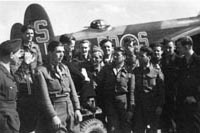
|
|
Reg
Boys [seated on bonnet] talks to former POWs before flying them
home to England onboard S Sugar
|
S
for
Sugar - Lancaster Serial Number R5868
Flew 137 operational sorties
Wing span 102ft
Length 69ft 6in
Height 20ft 6in
Engines
4 x rolls Royce Merlin MkXX - Later replaced by Merlin Mk 22
1480 horse power each
|
|
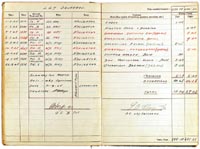
|
|
A
sample of Reg Boys’ meticulous record of operations over Reich
territory, including two flights aboard S for Sugar
|
Barely a mission
went by that someone didn't come home, however, and, oddly, according to
Reg, it was the people on the ground who seemed to feel the loss most.
The ladies
in the kitchens seemed hardest hit. It was their duty to feed the men
before and after a mission.
Each aviator
was rationed in for one egg after his flight and to keep tabs on how many
eggs to cook, the kitchens were tuned in to the control-tower radios.
So it was that the cooks heard first-hand whom of the men they had fed
just hours earlier would miss out on the one little luxury afforded them
despite the general rationing across the country.
The truck
drivers who ferried crews to and from the flight line and the mechanics
who looked after their aircraft also felt the loss.
Ground crew
were assigned to individual airplanes and were as much a part of the aircraft's
extended family as the men who flew it.
Reg and his
crew were presumed lost one night when they had fuel problems and had
to land at another airfield overnight and had missed a meal.
"When we
got back to base the next day, there was this amazing feeling among the
dozens of people who came out to greet us - there was almost a family
relationship between everyone."
The closest
Reg recounted coming to actual grief was on one mission when, shortly
after departure, the cabin began to fill with smoke. As with most aircraft
immediately after takeoff, the plane was far too heavy to attempt a safe
landing. Setting a course for The Wash - an area of sea off the English
east coast - to dump their bombs, Reg then assisted all available crew
to search for the source of the smoke.
Unsuccessful
in finding any fire, the captain decided to press on for Dusseldorf -
this night's target.
In the confusion,
Reg had not followed his charts and it took some time to get his bearings
in the blackness of the night. No sooner had he satisfied himself of where
exactly they were than the aircraft was locked in the converging beams
of several searchlights - an occurrence as dangerous as it was unnerving.
"Corkscrew
starboard," a gunner called out. The pilot immediately threw the sturdy
Lancaster into an evasion manoeuvre the crew had discussed and practiced
many times. Inputting full aileron control to turn the wings vertical,
then kicking in full bottom rudder, the heavily laden bomber entered a
vertical dive before pulling out in a corkscrew turn at the bottom - successfully
shaking the attention of the lights.
The Lancaster
was a pretty big airplane to throw around the sky like that, but Reg says
she could handle it.
"The pilot
would never pull a stunt like that without asking first or without the
call from the gunners or someone else, however.
"That's how
much of a crew we were - a unit."
On another
occasion, Reg remembers the confidence of his training kicking in to again
possibly save his comrades.
Europe and
England was pretty dark at night because of the blackouts. Navigation
was assisted by pathfinder bombers who dropped marker flares at mission-designated
points to give navigators a fix.
"One night,
coming home from Berlin, I had no sooner said, "We should be seeing the
markers any minute now" than the pilot spotted it way off to our left."
"Should we
fly to it?" the pilot asked.
"No, let
me make a check - no, I'm sure the PFF [pathfinder flight] have made a
blue - they've dropped the markers north-west of the wrong town."
"Are you
sure?" the anxious pilot demanded.
"Just keep
an eye out to port. If I'm right, those other guys will cop the flack
over the islands in about four minutes.
"And sure
enough, just on four minutes later, the sky off to our left lit up with
a barrage of flack."
Rather than
bask in his own sureness, however, Reg joined in a silent vigil as the
crew rode, mentally, through the barrage with their unseen colleagues.
Reg says
a quiet prayer never went astray.
"I figured
there must be someone out there looking out for us and I was never afraid
to say a quiet prayer before takeoff.
"But I was
never one for leaving things to luck.
"Some guys
seemed to live in the moment, but I always had a mind to the next night
and the night after that.
"I remember
one crew that was having a hell of a party one night and the next night
they went missing. Now, whether the two were connected or not you couldn't
tell - or were they just unlucky.
"I didn't
like to leave anything to luck, and that was the way our crew always worked,
and we survived to tell about it."
But lady
luck can deal her cards against you despite well-intentioned planning.
"One night
we swung on the runway - twice - with a full load of bombs on board.
"S Sugar
had lost half a wing on a mission and this was her first flight back after
repairs and her controls were a little out of balance.
"It was a
hairy experience, but we eventually got her off the ground, got the job
done and got her home again."
S for Sugar,
in which Reg logged 14 flights, is one of England's most respected and
loved bombers (like our own G for George), today lovingly restored and
on display at the RAF Museum, Hendon.
Lancaster
bomber serial number R5868 was built in 1942 and commenced service with
RAF's No 83 Sqn. Known then as Q for Queenie, she completed a not-insignificant
68 operations.
No 467 Sqn,
Royal Australian Air Force, was raised at Scampton, Lincolnshire, on 7
November 1942, moving a month later to Bottesford, Leicestershire - and
commenced operations in January '43. Q for Queenie was allocated to B
flight of the squadron and renamed S for Sugar.
She went
on to war's end, finally clocking up a remarkable 137 operational sorties
before No 467 Sqn was disbanded in September 1945.
|
|
|
“By
Jove, home at last” – crews customising their aircraft
for Operation Exodus
|
On 7 May 1945,
Reg Boys, navigating for squadron OC Wing Commander Ian Hay, flew on Sugar's
final mission - a "cook's tour" of German cities to observe the effects
of bombing raids and to assess the suitability of certain airfields to accept
heavy aircraft.
"We nearly
didn't take Sugar on that flight," Reg says, "She was down for repairs.
But I said to the OC the day before that if he told the maintenance boys
where we were taking her, they would see she was ready.
"And sure
enough, I think they worked through the night to send her on her last
sortie" - Right into the heart of the Reich territory.
|

